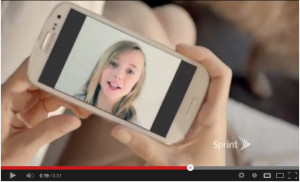The Courtesy of Seduction
Ever feel that irk, right in the middle of an especially intimate conversation you’re having with someone at a restaurant–say you’re about to ask them to to marry you (or move out)–when the perky waiter pops in to ask if you’d like your iced tea refilled or if you’d like to see the dessert menu? Magic gone. Moment lost.
Of course, the waiter doesn’t know you were in the midst of a life-altering conversation. He’s just doing his job (though I think he really does know, mischievously). But this isn’t about the bad timing of waiters, it’s about empathizing with your advertising audience’s feeling of being interrupted.
Whenever you run an ad, you’re interrupting somebody. They may be reading a fascinating article. Or watching a nail-biting movie. Or trying to watch a viral video of some stupid idiot falling off a roof. Or listening to an infuriating conversation on talk radio. Suddenly, at the worst possible time, in you pop, like that interrupting waiter, to tell them they may be paying too much for their wireless data plan. So chances are pretty good that your ad you’re so proud of has more than likely just pissed them off. Not a good start.
All advertising is just plain rude.
I remember taking my very first ad design class at Art Center College of Design from veteran art director Ray Engle, and the first thing he said on the first day was, “All advertising is an interruption. It’s rude.” He went on to say that when you conceive an ad, say a TV spot, you need to empathize with that person sitting on the couch . He isn’t waiting on the edge of his seat for your commercial. He’s watching a show. And you’ve just interrupted him and broken his concentration, and, more than likely, ruined his mood. Worse, if he was watching some program he was not that into, he’s much more likely to change channels. Or worse yet, just turn the damn thing off to go out and enjoy the beautiful day. We can’t have that! Civilization as we know it would collapse.
The crits of our amateurish concepts in that first advertising class all started with Engle’s primary criterion, “Is this this worth the interruption?” If not, it got ripped off the wall (Art Center is a harsh school).
So it had better be worth it.
But what can we do?
But if all advertising is an interruption and is just going to piss people off, what can we do?
Well, for one thing, you can try a little old fashioned seduction. Make sure that if you do run an ad, it’s not dull. Or irritating. This is where creativity comes in. Ads that entertain are not being gratuitously funny at the expense of the advertiser. Entertainment serves a vital function. It holds the attention of the viewer just long enough to keep them from fast forwarding, changing channels, or clicking “Skip Ad”.
It also makes a peace offering, rewarding the person you’ve just interrupted with a joke, or at least something of interest…so they’re not as irritated. It’s sort of like the slab of steak the cartoon cat offers Butch the Bulldog so he can sneak past him to get to that evil mouse. Think of your intended audience as the bulldog and the mouse as his inner desires…and you’re the cat. Or pick your own metaphor. I don’t care.
In short, don’t sell, seduce.
Skip-proofing your message
Nowadays technology makes it is easier than ever to filter out advertising. And the only way to fight against that if you’re an advertiser is to make sure people don’t want to filter it. This is the role of entertainment. It’s the slab of steak. Or the cheese. And you don’t crave the steak or the cheese because you need protein and calcium; you eat them because they’re delicious. (If you’re a vegan then, of course, this doesn’t apply and you are impervious to seduction).
You’d think marketers would realize this. Instead I’ve read so many posts and heard so many advertising professionals denigrate the role of entertainment in their advertising, that it’s somehow just useless, existing only to keep childish creative people employed. Or that it isn’t professional. And that the new marketing all depends on getting to the psychometrically targeted customer, so you can close that sale as efficiently as possible. The new marketers have water glasses to refill and dessert menus to proffer and tables to clear. But since they don’t seem to appreciate that the people they want to sell to don’t necessarily want to be sold to (even if psychometrically targeted), they’ve forgotten the simple courtesy of seduction.
There’s nothing wrong with seduction.
Seduction is a good thing. It’s respectful. It’s at the heart of all brand marketing. It may be quaint and old fashioned but it’s still a part of human behavior.
Compare these two marketing techniques:
The quaint, old-fashioned, brand marketing way: You take somebody out for a nice dinner. You make witty conversation. You make them laugh. You laugh at their jokes. You listen to them and show you care about them. You call them the next day to see how they are. You make another date (if you both had fun on the first one). You repeat, cultivating the relationship into something meaningful and mutually fulfilling. You get married and have beaucoup kids.
(At least that’s how I think seduction is supposed to work. Hm. Maybe that explains something in my own life.)
The new, hot, direct marketing way: You find a targeted qualified lead with an online SEM tool and hit them with, “Hey, have sex with me! There’s a chance for dinner at a moderately priced restaurant. But wait, there’s more, if you’re willing to do some ‘other things’ (wink, wink) there might be a movie in it for you, too. But only if you act in the next hour.” You then add them to your CRM and invite them to “like” your Facebook page.
Which technique would work better on you? (See how I care about what you think.)


